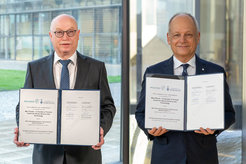Good neural connections
The Max Planck – University of Toronto Centre for Neural Science and Technology is now up and running

The brain is the best computer there is. Even if certain computers are better suited to handling specific tasks, they are still no match to the versatility of the human brain. The brain can thus serve as a blueprint for more powerful computers. But in order to emulate it, neuroscientists must first gain a better understanding of how it works. Researchers at the Max Planck – University Toronto Centre for Neural Science and Technology are therefore developing methods to enable this. They hope to use this better understanding of nerves and neuronal circuits to develop new approaches for treating neurodegenerative diseases such as Alzheimer’s and Parkinson’s disease.
“My impression is that after decades of basic research, we are crossing a threshold and can now use the various methods to make a huge leap in understanding fundamental cognitive functions and treating diseases”, said Martin Stratmann at the opening. “The array of tools also helps us to push forward the development of an artificial intelligence based on the biological model”. However, the huge leap is possible only if the tools are combined wisely and advances with respect to technology and interfaces with the brain are made.
Twelve Max Planck Institutes involved in the participation
This is exactly what the new centre is supposed to do: “The Max-Planck-Gesellschaft and the University of Toronto are ideally placed to work closely together”, says Meric Gertler, President of the University of Toronto. “This becomes particularly clear when you look at our combined capabilities in research on brain function and diseases”. On the part of the Max-Planck-Gesellschaft, 11 other institutes for example in the neurosciences, among others, are participating in the cooperation in addition to the Max Planck Institute of Microstructure Physics (MPI-MSP).

Joyce Poon, who is a Director at both the MPI-MSP and the Centre for Neural Science and Technology, explains how the skills of the various partners complement each other: “The Max-Planck-Gesellschaft is strong in basic research, especially in neuroscience, materials science, and optics”, says Poon. In addition, the University of Toronto is particularly good at directly targeting research to societal needs – and is correspondingly strong in technology, computer science, and clinically oriented medical research. Poon’s Co-Director Taufik Valiante, a neurosurgeon and researcher at the University of Toronto, therefore emphasizes: “The centre is another important component of the neurotechnology ecosystem that is growing here at the University of Toronto as well as at the participating hospitals of the Toronto Academic Health Science Network. It also exemplifies the interdisciplinary work that is urgently needed to advance neuroscience”.
Towards neuroscientific insights with implantable sensors
The cooperation partners will pursue several sub-projects in the centre. “Initially, we want to use micro- and nanotechnology to develop sensors and actuators to study and stimulate neural circuits in both cell cultures and living organisms”, explains Poon, an expert in the field. The implantable instruments created will be used by the scientists to measure the activity of individual neurons in animals with high spatial and temporal resolution and to relate this to the behaviour of the animals. To complement this, they will conduct experiments on human nerve cells to explore what exactly makes the human brain so special. Theoretical and biophysical model studies also contribute to a better understanding of how our brain works. Based on the knowledge they acquire, the researchers plan to develop new types of computer components for machine learning algorithms, which is currently the most important approach in artificial intelligence.
In order to achieve its goals, the centre will strengthen interdisciplinary cooperation and impart the cross-disciplinary knowledge and skills to young scientists. In five years, around 25 students will be able to do their doctorate at the new centre, thereby gaining experience both at Max Planck Institutes and in various groups at the University of Toronto.
At the opening, Sabine Sparwasser, German Ambassador to Canada, described the partnership of the two Institutes, each pursuing these goals with their respective capabilities, as “a match made in heaven”. With the Max-Planck-Gesellschaft and the University of Toronto, two of the world’s best research institutions have joined forces to explore the unparalleled computer system of our brain. This also gives Stéphane Dion cause for high hopes. “There is no doubt that the Max Planck – University of Toronto Centre for Neural Science and Technology will open up a new chapter in a research tradition that combines superior capabilities from two of the world’s most innovative countries”.













